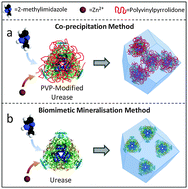Enzyme encapsulation in zeolitic imidazolate frameworks: a comparison between controlled co-precipitation and biomimetic mineralisation†
Abstract
Recent studies have demonstrated that metal–organic frameworks can be employed as protective coatings for enzymes. Two efficient strategies have been reported for the synthesis of such composite materials: biomimetic mineralisation and controlled co-precipitation using polyvinylpyrrolidone. We assessed the relative efficacy of each approach by comparing the thermal stability of encapsulated urease. The resulting data shows that over a range of temperatures biomimetic mineralisation offers superior protection than the co-precipitation method.


 Please wait while we load your content...
Please wait while we load your content...